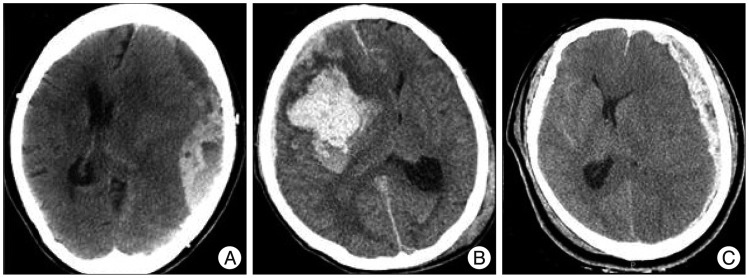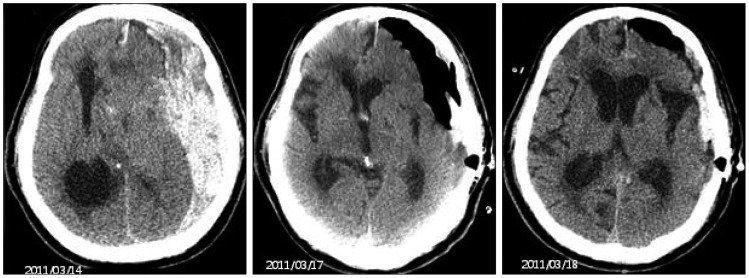J Korean Neurosurg Soc.
2014 Apr;55(4):195-199. 10.3340/jkns.2014.55.4.195.
Surgical Decision Making for the Elderly Patients in Severe Head Injuries
- Affiliations
-
- 1Department of Neurosurgery, Soonchunhyang University Cheonan Hospital, Cheonan, Korea. ksleens@sch.ac.kr
- KMID: 2191091
- DOI: http://doi.org/10.3340/jkns.2014.55.4.195
Abstract
OBJECTIVE
Age is a strong predictor of mortality in traumatic brain injuries. A surgical decision making is difficult especially for the elderly patients with severe head injuries. We studied so-called 'withholding a life-saving surgery' over a two year period at a university hospital.
METHODS
We collected data from 227 elderly patients. In 35 patients with Glasgow Coma Score 3-8, 28 patients had lesions that required operation. A life-saving surgery was withheld in 15 patients either by doctors and/or the families (Group A). Surgery was performed in 13 patients (Group B). We retrospectively examined the medical records and radiological findings of these 28 patients. We calculated the predicted probability of 6 month mortality (IPM) and 6 month unfavorable outcome (IPU) to compare the result of decision by the International Mission for Prognosis and Analysis of Clinical Trials in TBI (IMPACT) calculator.
RESULTS
Types of the mass lesion did not affect on the surgical decision making. None of the motor score 1 underwent surgery, while all patients with reactive pupils underwent surgery. Causes of injury or episodes of hypoxia/hypotension might have affected on the decision making, however, their role was not distinct. All patients in the group A died. In the group B, the outcome was unfavorable in 11 of 13 patients. Patients with high IPM or IPU were more common in group A than group B. Wrong decisions brought futile cares.
CONCLUSION
Ethical training and developing decision-making skills are necessary including shared decision making.
MeSH Terms
Figure
Reference
-
1. Andrews PJ, Sleeman DH, Statham PF, McQuatt A, Corruble V, Jones PA, et al. Predicting recovery in patients suffering from traumatic brain injury by using admission variables and physiological data : a comparison between decision tree analysis and logistic regression. J Neurosurg. 2002; 97:326–336. PMID: 12186460.
Article2. Cagetti B, Cossu M, Pau A, Rivano C, Viale G. The outcome from acute subdural and epidural intracranial haematomas in very elderly patients. Br J Neurosurg. 1992; 6:227–231. PMID: 1632921.
Article3. Chamoun RB, Robertson CS, Gopinath SP. Outcome in patients with blunt head trauma and a Glasgow Coma Scale score of 3 at presentation. J Neurosurg. 2009; 111:683–687. PMID: 19326973.
Article4. Chaudhuri K, Malham GM, Rosenfeld JV. Survival of trauma patients with coma and bilateral fixed dilated pupils. Injury. 2009; 40:28–32. PMID: 19070839.
Article5. Frosch DL, Kaplan RM. Shared decision making in clinical medicine : past research and future directions. Am J Prev Med. 1999; 17:285–294. PMID: 10606197.
Article6. Hahm KH, Lee I. Biomedical ethics policy in Korea : characteristics and historical development. J Korean Med Sci. 2012; 27(Suppl):S76–S81. PMID: 22661876.7. Honeybul S, Gillett GR, Ho KM, Lind CR. Neurotrauma and the rule of rescue. J Med Ethics. 2011; 37:707–710. PMID: 21947803.
Article8. Honeybul S, Ho K, O'Hanlon S. Access to reliable information about long-term prognosis influences clinical opinion on use of lifesaving intervention. PLoS One. 2012; 7:e32375. PMID: 22384231.
Article9. Honeybul S, Ho KM, Lind CR, Gillett GR. Surgical intervention for severe head injury : ethical considerations when performing life-saving but non-restorative surgery. Acta Neurochir (Wien). 2011; 153:1105–1110. PMID: 21347576.
Article10. Honeybul S, O'Hanlon S, Ho KM. Decompressive craniectomy for severe head injury : does an outcome prediction model influence clinical decision-making? J Neurotrauma. 2011; 28:13–19. PMID: 20979568.
Article11. Hukkelhoven CW, Steyerberg EW, Rampen AJ, Farace E, Habbema JD, Marshall LF, et al. Patient age and outcome following severe traumatic brain injury : an analysis of 5600 patients. J Neurosurg. 2003; 99:666–673. PMID: 14567601.
Article12. Kotwica Z, Saracen A. Severe head injuries in the elderly. Hygeia Public Health. 2010; 45:197–201.13. Kuhne CA, Ruchholtz S, Kaiser GM, Nast-Kolb D. Working Group on Multiple Trauma of the German Society of Trauma. Mortality in severely injured elderly trauma patients--when does age become a risk factor? World J Surg. 2005; 29:1476–1482. PMID: 16228923.
Article14. Lingsma HF, Roozenbeek B, Steyerberg EW, Murray GD, Maas AI. Early prognosis in traumatic brain injury : from prophecies to predictions. Lancet Neurol. 2010; 9:543–554. PMID: 20398861.
Article15. Mak CH, Wong SK, Wong GK, Ng S, Wang KK, Lam PK, et al. Traumatic brain injury in the elderly : is it as bad as we think? Curr Transl Geriatr Exp Gerontol Rep. 2012; 1:171–178. PMID: 24014175.16. MRC CRASH Trial Collaborators. Perel P, Arango M, Clayton T, Edwards P, Komolafe E, et al. Predicting outcome after traumatic brain injury : practical prognostic models based on large cohort of international patients. BMJ. 2008; 336:425–429. PMID: 18270239.
Article17. Mushkudiani NA, Engel DC, Steyerberg EW, Butcher I, Lu J, Marmarou A, et al. Prognostic value of demographic characteristics in traumatic brain injury : results from the IMPACT study. J Neurotrauma. 2007; 24:259–269. PMID: 17375990.
Article18. Patel HC, Bouamra O, Woodford M, Yates DW, Lecky FE. Clinical article : mortality associated with severe head injury in the elderly. Acta Neurochir (Wien). 2010; 152:1353–1357. discussion 1357. PMID: 20437280.
Article19. Pilitsis J, Atwater B, Warden D, Deck G, Carroll J, Smith J, et al. Outcomes in octogenarians with subdural hematomas. Clin Neurol Neurosurg. 2013; 115:1429–1432. PMID: 23428139.
Article20. Rennie SC, van Rij AM, Jaye C, Hall KH. Defining decision making : a qualitative study of international experts' views on surgical trainee decision making. World J Surg. 2011; 35:1214–1220. PMID: 21472366.
Article21. Schaller C, Kessler M. On the difficulty of neurosurgical end of life decisions. J Med Ethics. 2006; 32:65–69. PMID: 16446408.
Article22. Steyerberg EW, Mushkudiani N, Perel P, Butcher I, Lu J, McHugh GS, et al. Predicting outcome after traumatic brain injury : development and international validation of prognostic scores based on admission characteristics. PLoS Med. 2008; 5:e165. discussion e165. PMID: 18684008.23. Stocchetti N, Paternò R, Citerio G, Beretta L, Colombo A. Traumatic brain injury in an aging population. J Neurotrauma. 2012; 29:1119–1125. PMID: 22220762.
Article
- Full Text Links
- Actions
-
Cited
- CITED
-
- Close
- Share
- Similar articles
-
- Public Health Nurses' Decision Making Models and Their Knowledge Structure
- Surgical decision making for symptomatic pelvic organ prolapse: evidence-based approach
- Surgical management for elderly patients with pancreatic cancer
- The role of nurses in shared decision-making about caring for older adults with chronic disease: A qualitative descriptive study
- Factors Influencing Conflicts of Chemotherapy Decision Making among Pre-Operative Cancer Patients





